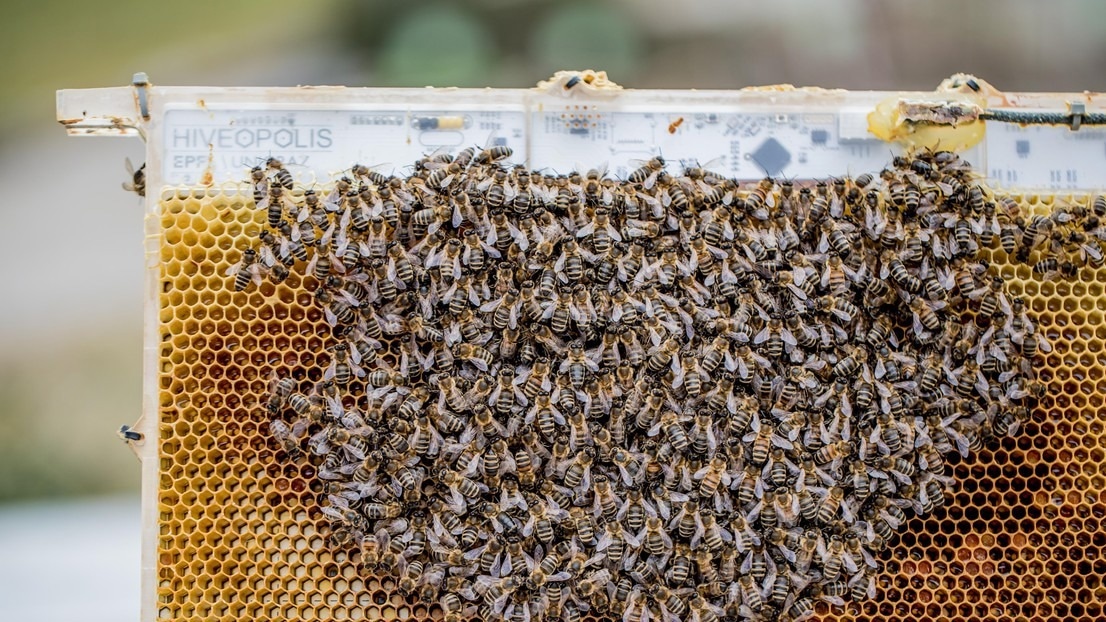A temperature-modulating robotic system that has been developed by scientists at EPFL (École polytechnique fédérale de Lausanne) could be smoothly combined into notoriously sensitive honeybee hives. Thus, it offers both a never-before-seen view of honeybee behavior and a way to influence it.

The robotic system is shown in an experimental hive. Image Credit: © Artificial Life Lab / University of Graz / Hiveopolis
Honeybees are notably particular when it comes to being studied. The colony’s behavior could be disrupted by research instruments and conditions and also strange smells.
Currently, a collaborative research group from the Mobile Robotic Systems Group in EPFL’s School of Engineering and School of Computer and Communication Sciences and the Hiveopolis project at Austria’s University of Graz has come up with a robotic system that could be modestly built into the frame of a standard honeybee hive.
Made of an array of thermal actuators and sensors, the system quantifies and regulates honeybee behavior via localized temperature variations.
Many rules of bee society—from collective and individual interactions to raising a healthy brood – are regulated by temperature, so we leveraged that for this study. The thermal sensors create a snapshot of the bees’ collective behavior, while the actuators allow us to influence their movement by modulating thermal fields.
Rafael Barmak, Ph.D. Student and Study First Author, École polytechnique fédérale de Lausanne
Barmak is the study author of the paper that has been recently reported in the Science Robotics journal.
Previous studies on the thermal behavior of honeybees in winter have relied on observing the bees or manipulating the outside temperature. Our robotic system enables us to change the temperature from within the cluster, emulating the heating behavior of core bees there, and allowing us to study how the winter cluster actively regulates its temperature.
Martin Stefanec, University of Graz
A “Biohybrid Superorganism” to Mitigate Colony Collapse
It is hard to study Bee colonies in winter as they are sensitive to cold, and opening their hives risks hurting and influencing their behavior. However, as a result of the biocompatible robotic system of the scientists’, they were capable of studying three experimental hives, situated at the Artificial Life Lab at the University of Graz, during winter and regulating them from EPFL in a remote manner.
Within the device, a central processor coordinated the sensors, transmitted commands to the actuators, and sent data to the researchers. .
Francesco Mondada, the head of Mobile Robotic Systems Group, describes that one of the most significant views of the system—which he calls a “biohybrid superorganism” for its integration of robotics with a colony of individuals that serve as a living entity—is its opportunity to concurrently note and influence the behavior of bee.
“By gathering data on the bees’ position and creating warmer areas in the hive, we were able to encourage them to move around in ways they would never normally do in nature during the winter, when they tend to huddle together to conserve energy. This gives us the possibility to act on behalf of a colony, for example by directing it toward a food source, or discouraging it from dividing into too-small groups, which can threaten its survival.”
It was possible for researchers to extend the survival of a colony after the death of its queen by dispensing heat energy through the actuators. The potential of the system to alleviate colony collapse could have effects on bee survivability. This has turned out to be an increasing food and environmental security concern as there is a fall in the worldwide population of pollinators.
Never-Before-Seen Behaviors
Besides its possibility to support colonies, the system has made clear honeybee behaviors, thereby setting the stage for new avenues in biological research.
The local thermal stimuli produced by our system revealed previously unreported dynamics that are generating exciting new questions and hypotheses. For example, currently, no model can explain why we were able to encourage the bees to cross some cold temperature ‘valleys’ within the hive.
Rob Mills, Study Corresponding Author and Postdoctoral Researcher, École polytechnique fédérale de Lausanne
Currently, scientists are planning to use the system to study bees in the summertime, which is considered to be a crucial period for raising young. At the same time, the Mobile Robotic Systems Group has been exploring systems with the help of vibrational pathways to interact with honeybees.
Mondada stated, “The biological acceptance aspect of this work is critical: the fact that the bees accepted the integration of electronics into the hive gives our device great potential for different scientific or agricultural applications.”
This work was financially supported by the EU H2020 FET project HIVEOPOLIS (no. 824069), unified by Thomas Schmickl, and by the Field of Excellence COLIBRI (Complexity of Life in basic Research and Innovation) at the University of Graz.
Journal Reference
Barmak, R., et al. (2023) A robotic honeycomb for interaction with a honeybee colony. Science Robotics. doi.org/10.1126/scirobotics.add7385.